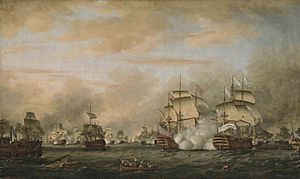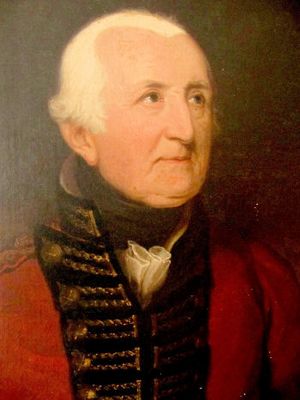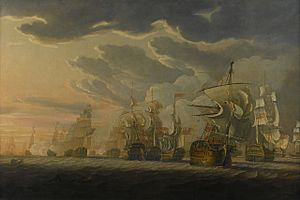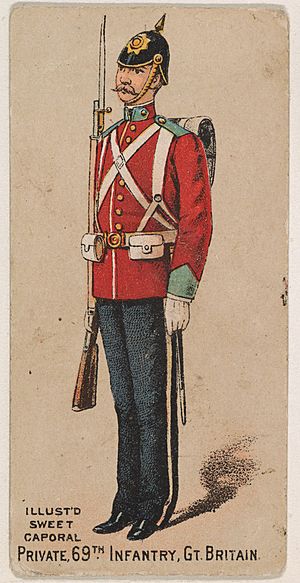69th (South Lincolnshire) Regiment of Foot facts for kids
Quick facts for kids 69th (South Lincolnshire) Regiment of Foot |
|
|---|---|
| Active | 10 December 1756–1 July 1881 |
| Country | |
| Branch | |
| Type | Infantry |
| Size | One battalion (two battalions 1795–1796 and 1803–1816) |
| Garrison/HQ | Maindy Barracks, Cardiff |
| Nickname(s) | The Ups and Downs The Old Agamemnons |
| Engagements | Seven Years' War Napoleonic Wars Fenian raids |
The 69th (South Lincolnshire) Regiment of Foot was a group of infantry soldiers in the British Army. It was first formed in 1756. Later, in 1881, it joined with another group, the 41st (Welch) Regiment of Foot, to create the Welch Regiment. This change happened because of new army rules called the Childers Reforms.
Contents
A Look Back: The Regiment's Story
How the 69th Regiment Began
The regiment was created because the army needed more soldiers. This was at the start of the Seven Years' War. On August 25, 1756, the army decided that some existing regiments should form a second group of soldiers. The 24th Regiment of Foot was one of these.
The second group of the 24th Regiment was formed on December 10, 1756. It was later given a new number, becoming the 69th Regiment of Foot, on April 21, 1758.
The regiment took part in a surprise attack on St Malo in June 1758. Then, in spring 1761, they helped capture Belle Île. Later that year, they sailed to the West Indies. In January 1762, they were part of the attack on Martinique. They came back home in 1763.
In November 1781, the regiment went back to the West Indies. They fought in the Battle of Saint Kitts in January 1782. They also served as marines (soldiers on ships) in the Battle of the Saintes in April 1782. In August 1782, the regiment got its county name: the 69th (South Lincolnshire) Regiment of Foot. They returned home in 1785.
Fighting in the Napoleonic Wars
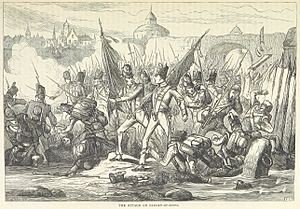
In early 1793, some soldiers from the regiment served as marines on ships. They fought on the ship HMS Leviathan during the capture of Toulon in December 1793. They also fought at the attack on the Tour de Mortella in February 1794. In June 1794, they were at the Glorious First of June sea battle.
These soldiers then moved to another ship, HMS Agamemnon. They served under Lord Nelson. They fought at the Battle of Genoa in March 1795. After Nelson moved to the ship Captain in June 1796, they were with him at the Battle of Cape St Vincent in February 1797. During this battle, a soldier from the 69th Regiment, Matthew Stevens, was the first to board a Spanish ship called San Nicolas.
The main part of the regiment went back to the West Indies in 1796. They were part of a British attack on Saint-Domingue (now Haiti). Sadly, almost half of them got yellow fever. After returning home in 1798, the regiment took part in the Anglo-Russian invasion of Holland in August 1799. They moved to Jamaica in July 1800 and came home again in June 1802.
A second group of soldiers (a second battalion) was formed in 1803. The first group sailed to India in 1805. They helped stop the Vellore mutiny in July 1806 and the Travancore Rebellion in spring 1809. They also saw action during the Invasion of Île Bonaparte in July 1810, the Invasion of Isle de France in December 1810, and the Invasion of Java in August 1811.
Meanwhile, the second group went to the Netherlands in 1813. They fought in the Siege of Bergen op Zoom in March 1814. They also fought in the famous battles of Quatre Bras and Battle of Waterloo. At Quatre Bras, the regiment's special flag, the King's Colour, was captured by the enemy. Their commanding officer, Lieutenant-Colonel Charles Morice, was killed during a French cavalry attack. The two groups of soldiers joined back together in 1816.
The Victorian Era and Beyond
In November 1831, the regiment sailed to the West Indies. They were stationed in Saint Vincent and then moved to Demerara in 1835. In January 1839, they sailed to Halifax in Nova Scotia, before returning home in September 1842.
They arrived in Malta in December 1847. Then they went to Barbados in 1851, returning to England in May 1857. They left for Burma later that year and then went to India in 1862. They came home again in May 1864.
In August 1867, they sailed to Canada. There, under the command of Lieutenant Colonel George Bagot, they helped stop a Fenian Raid at the Battle of Trout River in May 1870. Later that year, they sailed to Bermuda. They moved to Gibraltar in 1873 before returning home in 1878.
In the 1870s, new army rules called the Cardwell Reforms were put in place. These rules linked single-group regiments together. The 69th Regiment was linked with the 41st (Welch) Regiment of Foot. They shared a training base in Cardiff at Maindy Barracks. On July 1, 1881, the Childers Reforms came into effect. This is when the 69th Regiment officially joined with the 41st (Welch) Regiment of Foot to form the Welch Regiment.
Regiment Nicknames
The regiment had a nickname: "The Ups and Downs." Some people say this was because the group had both old, experienced soldiers and new, young recruits. Another idea is that it came from their number, 69, which looks the same if you turn it upside down!
Battle Honours
The regiment earned special awards called "battle honours" for their bravery in different fights. These included:


